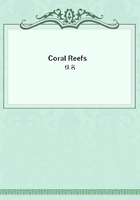
第25章
Within the reef of the Gambier group there are four large and some smaller islands (Figure 8, Plate I.); within that of Hogoleu (Figure 2, Plate I.) nearly a dozen small islands are scattered over the expanse of one vast lagoon.
After the details now given, it may be asserted that there is not one point of essential difference between encircling barrier-reefs and atolls: the latter enclose a simple sheet of water, the former encircle an expanse with one or more islands rising from it. I was much struck with this fact, when viewing, from the heights of Tahiti, the distant island of Eimeo standing within smooth water, and encircled by a ring of snow-white breakers.
Remove the central land, and an annular reef like that of an atoll in an early stage of its formation is left; remove it from Bolabola, and there remains a circle of linear coral-islets, crowned with tall cocoa-nut trees, like one of the many atolls scattered over the Pacific and Indian Oceans.
The barrier-reefs of Australia and of New Caledonia deserve a separate notice from their great dimensions. The reef on the west coast of New Caledonia (Figure 5, Plate II.) is 400 miles in length; and for a length of many leagues it seldom approaches within eight miles of the shore; and near the southern end of the island, the space between the reef and the land is sixteen miles in width. The Australian barrier extends, with a few interruptions, for nearly a thousand miles; its average distance from the land is between twenty and thirty miles; and in some parts from fifty to seventy. The great arm of the sea thus included, is from ten to twenty-five fathoms deep, with a sandy bottom; but towards the southern end, where the reef is further from the shore, the depth gradually increases to forty, and in some parts to more than sixty fathoms. Flinders (Flinders' "Voyage to Terra Australis," volume ii., page 88.) has described the surface of this reef as consisting of a hard white agglomerate of different kinds of coral, with rough projecting points. The outer edge is the highest part; it is traversed by narrow gullies, and at rare intervals is breached by ship-channels. The sea close outside is profoundly deep; but, in front of the main breaches, soundings can sometimes be obtained. Some low islets have been formed on the reef.
(PLATE: UNNAMED, THREE VERTICAL SECTIONS (WOODCUT DIAGRAMS):
1. VANIKORO, from the "Atlas of the Voyage of the 'Astrolabe'," by D.
D'Urville.
2. GAMBIER ISLAND, from Beechey.
3. MAURUA, from the "Atlas of the Voyage of the 'Coquille'," by Duperrey.
The horizontal line is the level of the sea, from which on the right hand a plummet descends, representing a depth of 200 fathoms, or 1,200 feet. The vertical shading shows the section of the land, and the horizontal shading that of the encircling barrier-reef: from the smallness of the scale, the lagoon-channel could not be represented.
AA.--Outer edge of the coral-reefs, where the sea breaks.
BB.--The shore of the encircled islands.)
There is one important point in the structure of barrier-reefs which must here be considered. The accompanying diagrams represent north and south vertical sections, taken through the highest points of Vanikoro, Gambier, and Maurua Islands, and through their encircling reefs. The scale both in the horizontal and vertical direction is the same, namely, a quarter of an inch to a nautical mile. The height and width of these islands is known; and I have attempted to represent the form of the land from the shading of the hills in the large published charts. It has long been remarked, even from the time of Dampier, that considerable degree of relation subsists between the inclination of that part of the land which is beneath water and that above it; hence the dotted line in the three sections, probably, does not widely differ in inclination from the actual submarine prolongation of the land. If we now look at the outer edge of the reef (AA), and bear in mind that the plummet on the right hand represents a depth of 1,200 feet, we must conclude that the vertical thickness of these barrier coral-reefs is very great.